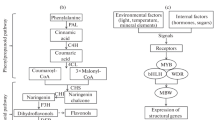Zusammenfassung
Die Anthocyane des Stengels von Hippuris vulgaris sind Cy-3-gluc und Cy-3-gal; bei der anthocyanärmeren Form, H. tetraphylla, wurde nur Cy-3-gluc beobachtet (1). Zur Klassifikation der Sippe vgl. Ref. (2, 3) und bei den Hydrostachyaceae.
Access this chapter
Tax calculation will be finalised at checkout
Purchases are for personal use only
Similar content being viewed by others
Literatur
G. Bendz and A. Haglund, Acta Chem. Scand. 21, 2569 (1967).
A. Penzes, Uber die systematische Stellung der Familie Hippuridaceae, Bot. Kozlem. 55, 183 (1968). Der Rostpilz Uromyces lineolatus bildet Teleutosporen auf Scirpus-Arten und Aecidien auf Umbelliferen, aber auch auf Hippuris vulgaris und Glaux maritima; da Umbelliferen und Hippuris Wirtspflan-zen dieses Rostpilzes sind, wird Verwandtschaft zwischen den zwei Sippen angenommen (vgl. dazu Stellung der Hippuridaceae in Hegi, 1. Aufl., Bd. V/2). Dazu ist zu bemerken, daft bei wirtswechselnden Rostpilzen die Aecidialphase oft auf taxonomisch nur entfernt verwandten Wirtspflanzen zu finden ist; vgl. dazu auch Holm in Hedberg, I.e. Bd.Vii, S.205 (Holm denkt eher an Hippuris-Glaux-als an /f/wns-Umbelliferen-Verwandtschaft) und Savile (1979), 1. c. Bd. Vii, S. 206.
R. Hegnauer (1967), 1. c. Bd. Vii, S. 200 und in J. B. Har-Borne and T. Swain (1969), 1.c. Bd. Vii, S. 200.
Afrostyrax, Hua und Huaceae bei Airy Shaw in Willis (1973).
P. Baas, The affinities of Hua Pierre and Afrostyrax Perkins et Gilg, Blumea 20, 162–192 (1972).
A. Raponda-Walker et R. Sillans 1961,1. c. Bd. Vii, S. 86: Hua sub Huaceae.
A. Bouquet 1969,1. c. Bd. Vii, S. 81: Afrostyrax und Hua sub Styracaceae.
A. Beijersbergen, A note on the che-motaxonomy of Huaceae, Blumea 20, 160 (1972).
Author information
Authors and Affiliations
Rights and permissions
Copyright information
© 1989 Springer Basel AG
About this chapter
Cite this chapter
Hegnauer, R. (1989). Hippuridaceae. In: Chemotaxonomie der Pflanzen. Lehrbücher und Monographien aus dem Gebiete der Exakten Wissenschaften, vol 30. Birkhäuser, Basel. https://doi.org/10.1007/978-3-0348-9283-4_117
Download citation
DOI: https://doi.org/10.1007/978-3-0348-9283-4_117
Publisher Name: Birkhäuser, Basel
Print ISBN: 978-3-0348-9977-2
Online ISBN: 978-3-0348-9283-4
eBook Packages: Springer Book Archive




